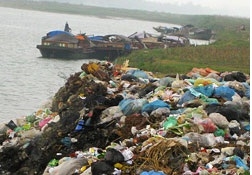Business activity in the famous craft village of Hoai Hao in the central province of Binh Dinh was quiet for years until most of the producers decided to purchase advanced machinery.
 |
| Waste is discharged from Loi Khanh trade village in the central province of Binh Dinh\'s Hoai Nhon District. |
Then production of rice paper, the village\'s main activity, rose in leaps and bounds , Nguyen Tinh, vice chairman of the People\'s Committee in Hoai Hao Commune, said.
The rise in production, however, has taken a serious toll on the environment, largely due to untreated wastewater being discharged by 200 establishments that produce wheat flour.
There is not a single wastewater treatment system in the entire district of Hoai Nhon, in which Hoai Hao Commune is located.
Every day, an average of nearly 6,000 cubic metres of untreated wastewater are discharged into the commune\'s waterways or soil, according to Nguyen Thanh Hau, deputy head of Hoai Nhon\'s Natural Resources and Environment Office.
The agency\'s deputy head, Nguyen Viet Cuong, said inspection results of the Binh Dinh Province\'s Environmental Protection Agency showed that wastewater from rice flour producers in Hoai Hao Village contained a high concentration of cyanide, which is toxic to humans.
"This has severely contaminated underground water sources and rivers in the surrounding areas," said Cuong.
All the water wells in Hoai Nhon\'s Tan Thanh 2 Village, where 100 flour production establishments are located, are extremely polluted and can no longer be used, according to the commune\'s Natural Resources and Environment Office.
Recently, commune authorities closed 192 production establishments in Hoai Hao craft village.
The push for buying modern machinery was part of a larger industrial promotion programme in Binh Dinh Province that began in 2005.
Under the programme, many traditional craft villages that had been facing closure have been revived.
At least 38 craft villages are now flourishing, representing 70 percent of the total number of villages planned for development in the province.
In the last five years, more than VND10 billion (USD488,000) from the State budget and local funds have been invested in programmes to build new rural areas in the province.
Although higher incomes have helped reduce hunger and poverty in the province, pollution problems resulting from the development have not been handled properly.
The Bau Da rice wine village in An Nhon District, for example, is one of the most successful craft villages, but it is facing serious environmental pollution.
To make Bau Da rice wine, which has been produced for hundreds of years, local water sources are used. But the water is heavily contaminated because of the development of pig husbandry on Cu Lam Hamlet.
Nhon Loc Commune authorities were taking steps to prevent pollution from contaminating the underground water source in Cu Lam Bac as the water source was the key factor for the quality of Bau Da wine, said Cao Van Nghia, deputy head of the People\'s Committee of the commune in An Nhon District.
Binh Dinh provincial authorities told Sai Gon Tiep Thi that they were unsure about how to both develop craft villages and protect the environment.
"Closing down nearly 200 wheat flour production villages was a very hard decision to make," said the chairman of Hoai Nhon People\'s Committee, Nguyen Quoc Viet. "But it is necessary to make people take responsibility in protecting the environment."
Solutions
The provincial Science and Technology Department had many times sent experts to Hoai Hao to conduct research and find solutions to the pollution problem. But they had failed to come up with any proper measures, said Tinh.
The Ho Chi Minh City University of Technology and the City\'s Institute of Environment and Natural Resources have proposed a solution that can only be implemented on a small scale.
A programme supported by the Swedish government, which targets easing pollution in Hoai Hao, has been also carried out, but only on an experimental basis in 10 households.
Households themselves have been trying to upgrade their wastewater treatment systems with the support of the local administration.
Following these improvements, however, only 80 households in Hoai Hao have been allowed to resume production.
"Most of the households lack knowledge to run waste water treatment systems," said Cuong, "and they have been doing this grudgingly."
The province\'s environmentalists said if there were no comprehensive measures taken on managing wastewater treatment, long-term environmental protection would never occur.
Cuong proposed gathering all the craft producers into an industrial complex.
To help save water sources for making Bau Da wine, Cuong said, the provincial Environmental Protection Agency had asked the local administration to financially support residents so they could build underground biogas containers to treat waste water discharged from pig-husbandry establishments.
The agency has been co-ordinating with responsible local bodies to develop measures that would protect underground water sources.

Leave your comment on this story